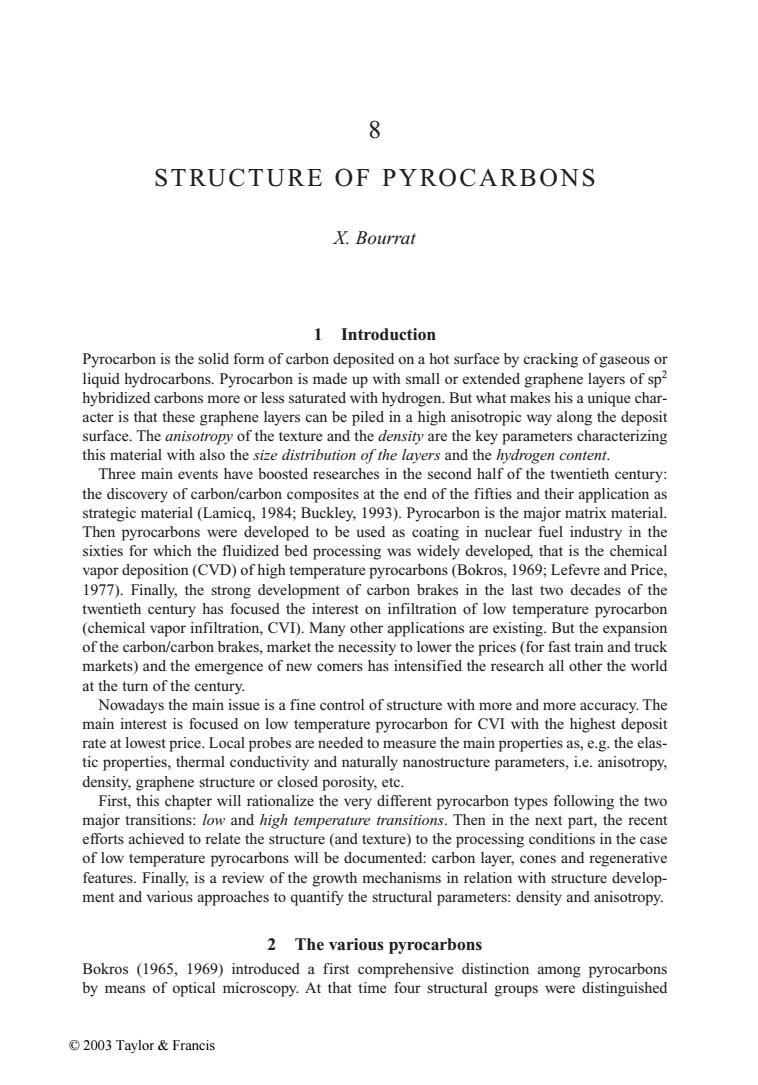正在加载图片...

8 STRUCTURE OF PYROCARBONS X.Bourrat 1 Introduction Pyrocarbon is the solid form of carbon deposited on a hot surface by cracking of gaseous or liquid hydrocarbons.Pyrocarbon is made up with small or extended graphene layers of sp2 hybridized carbons more or less saturated with hydrogen.But what makes his a unique char- acter is that these graphene layers can be piled in a high anisotropic way along the deposit surface.The anisotropy of the texture and the density are the key parameters characterizing this material with also the size distribution of the layers and the hydrogen content. Three main events have boosted researches in the second half of the twentieth century: the discovery of carbon/carbon composites at the end of the fifties and their application as strategic material (Lamicq,1984;Buckley,1993).Pyrocarbon is the major matrix material. Then pyrocarbons were developed to be used as coating in nuclear fuel industry in the sixties for which the fluidized bed processing was widely developed,that is the chemical vapor deposition(CVD)of high temperature pyrocarbons(Bokros,1969;Lefevre and Price, 1977).Finally,the strong development of carbon brakes in the last two decades of the twentieth century has focused the interest on infiltration of low temperature pyrocarbon (chemical vapor infiltration,CVD).Many other applications are existing.But the expansion of the carbon/carbon brakes,market the necessity to lower the prices (for fast train and truck markets)and the emergence of new comers has intensified the research all other the world at the turn of the century. Nowadays the main issue is a fine control of structure with more and more accuracy.The main interest is focused on low temperature pyrocarbon for CVI with the highest deposit rate at lowest price.Local probes are needed to measure the main properties as,e.g.the elas- tic properties,thermal conductivity and naturally nanostructure parameters,i.e.anisotropy, density,graphene structure or closed porosity,etc. First,this chapter will rationalize the very different pyrocarbon types following the two major transitions:low and high temperature transitions.Then in the next part,the recent efforts achieved to relate the structure (and texture)to the processing conditions in the case of low temperature pyrocarbons will be documented:carbon layer,cones and regenerative features.Finally,is a review of the growth mechanisms in relation with structure develop- ment and various approaches to quantify the structural parameters:density and anisotropy. 2 The various pyrocarbons Bokros (1965,1969)introduced a first comprehensive distinction among pyrocarbons by means of optical microscopy.At that time four structural groups were distinguished ©2003 Taylor&Francis8 STRUCTURE OF PYROCARBONS X. Bourrat 1 Introduction Pyrocarbon is the solid form of carbon deposited on a hot surface by cracking of gaseous or liquid hydrocarbons. Pyrocarbon is made up with small or extended graphene layers of sp2 hybridized carbons more or less saturated with hydrogen. But what makes his a unique character is that these graphene layers can be piled in a high anisotropic way along the deposit surface. The anisotropy of the texture and the density are the key parameters characterizing this material with also the size distribution of the layers and the hydrogen content. Three main events have boosted researches in the second half of the twentieth century: the discovery of carbon/carbon composites at the end of the fifties and their application as strategic material (Lamicq, 1984; Buckley, 1993). Pyrocarbon is the major matrix material. Then pyrocarbons were developed to be used as coating in nuclear fuel industry in the sixties for which the fluidized bed processing was widely developed, that is the chemical vapor deposition (CVD) of high temperature pyrocarbons (Bokros, 1969; Lefevre and Price, 1977). Finally, the strong development of carbon brakes in the last two decades of the twentieth century has focused the interest on infiltration of low temperature pyrocarbon (chemical vapor infiltration, CVI). Many other applications are existing. But the expansion of the carbon/carbon brakes, market the necessity to lower the prices (for fast train and truck markets) and the emergence of new comers has intensified the research all other the world at the turn of the century. Nowadays the main issue is a fine control of structure with more and more accuracy. The main interest is focused on low temperature pyrocarbon for CVI with the highest deposit rate at lowest price. Local probes are needed to measure the main properties as, e.g. the elastic properties, thermal conductivity and naturally nanostructure parameters, i.e. anisotropy, density, graphene structure or closed porosity, etc. First, this chapter will rationalize the very different pyrocarbon types following the two major transitions: low and high temperature transitions. Then in the next part, the recent efforts achieved to relate the structure (and texture) to the processing conditions in the case of low temperature pyrocarbons will be documented: carbon layer, cones and regenerative features. Finally, is a review of the growth mechanisms in relation with structure development and various approaches to quantify the structural parameters: density and anisotropy. 2 The various pyrocarbons Bokros (1965, 1969) introduced a first comprehensive distinction among pyrocarbons by means of optical microscopy. At that time four structural groups were distinguished © 2003 Taylor & Francis